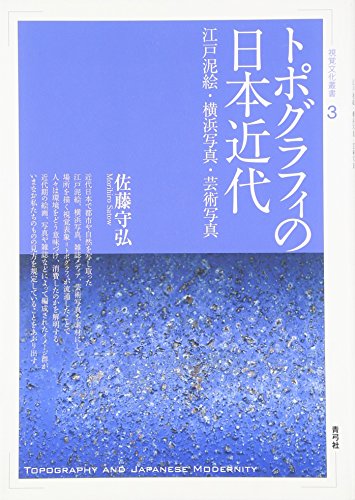11 0 0 0 OA ポピュラーカルチャーの美学構築に関する基盤研究
- 著者
- 室井 尚 佐藤 守弘 吉田 寛 吉岡 洋 秋庭 史典 島本 浣 安田 昌弘 小松 正史 吉村 和真 前川 修 大久保 美紀 丸山 美佳
- 出版者
- 横浜国立大学
- 雑誌
- 基盤研究(A)
- 巻号頁・発行日
- 2013-10-21
本研究は5名の研究代表者、分担者を中心とした研究会を複数回開催するとともに、大規模な公開研究集会を年に一回開催し、その成果を映像記録や報告書にまとめることによって、一般からもその成果に対する広い関心を集めることができた。最終年度には報告書として論文集を公刊した。また2014年の国際記号学会においてはラウンドテーブルを組織して、海外の研究者との議論を深めることができた。これらの研究活動によって新しい理論的な枠組の構築に結びつけることができた。本研究はポピュラー文化に関する美学的アプローチの最先端の成果を挙げることができた。
6 0 0 0 鉄道写真蒐集の欲望 : 20世紀初頭の日本における鉄道の視覚文化
- 著者
- 佐藤 守弘
- 出版者
- 京都精華大学
- 雑誌
- 京都精華大学紀要 (ISSN:09173986)
- 巻号頁・発行日
- no.39, pp.49-72, 2011
4 0 0 0 IR 郷愁と発見 : 日本近代の無気味な他者 (特集 視覚文化と<日本>)
- 著者
- 佐藤 守弘 サトウ モリヒロ Satow Morihiro
- 出版者
- 大阪大学文学部・大学院文学研究科
- 雑誌
- 大阪大学日本学報 (ISSN:02864207)
- 巻号頁・発行日
- no.34, pp.13-28, 2015-03
2 0 0 0 OA 文化遺産としての大衆的イメージ-近代日本における視覚文化の美学美術史学的研究
- 著者
- 金田 千秋 加藤 哲弘 島本 浣 山田 俊幸 及川 智早 佐藤 守弘 石田 あゆう 岸 文和 前川 修 中谷 伸生 橋爪 節也 鈴木 廣之 太田 孝彦 石田 美紀
- 出版者
- 筑波大学
- 雑誌
- 基盤研究(B)
- 巻号頁・発行日
- 2008
本研究は、大正期に流通していた大衆的な視覚表象に関する2つの課題を、豊かな対話関係において、遂行するものである。すなわち、第1の課題は、大衆的な視覚表象が果たしていたメディア的な機能の多様性を、可能な限り広範な資料に基づいて、美術史学的に明らかにすることである。第2の課題は、「文化遺産」の概念を鍛え上げることによって、何らかの大衆的イメージが後世に継承される/るべきさいの条件・方法などを、美学的に考察することである。
- 著者
- 佐藤 守弘
- 出版者
- 同志社大学文化学会
- 雑誌
- 文化学年報 (ISSN:02881322)
- 巻号頁・発行日
- vol.62, pp.354-367, 2013-03
2 0 0 0 トポグラフィの日本近代 : 江戸泥絵・横浜写真・芸術写真
2 0 0 0 痕跡と記憶--遺影写真論
- 著者
- 佐藤 守弘
- 出版者
- 帝塚山学院大学美学美術史・芸術学研究室
- 雑誌
- 藝術論究 (ISSN:09172505)
- 巻号頁・発行日
- vol.29, pp.39-59, 2002-03
1 0 0 0 OA ポップカルチャー・ワールド概念を用いたポップカルチャー美学の構築に関わる基盤研究
- 著者
- 室井 尚 吉岡 洋 秋庭 史典 佐藤 守弘 吉田 寛 小松 正史 安田 昌弘 島本 浣 吉村 和真 須川 亜紀子 カルパントラ ファビアン 大久保 美紀 丸山 美佳 入江 哲朗 ロート マーティン 簗瀬 洋平 井上 明人 小島 秀夫 バラカン ピーター 輪島 裕介 増田 聡 松蔭 浩之 前川 修 増田 展大
- 出版者
- 横浜国立大学
- 雑誌
- 基盤研究(A)
- 巻号頁・発行日
- 2016-04-01
本研究は5名の研究代表者、分担者を中心とした研究会を複数回開催するとともに、大規模な公開研究集会を年に一回開催し、その成果をや報告書にまとめ、webで幅広く公開することによって、一般からもその成果に対する広い関心を集めることができた。また2016年の国際美学会、2017年の国際記号学会においてはラウンドテーブルを組織して、海外の研究者との議論を深めることができた。これらの研究活動によって新しい理論的な枠組の構築に結びつけることができた。本研究はポピュラー文化に関する美学的アプローチの最先端の成果を挙げることができた。
1 0 0 0 OA Representing "Old Japan":
- 著者
- 佐藤 守弘 Lori HITCHCOCK MORIMOTO
- 出版者
- Japan Society of Image Arts and Sciences
- 雑誌
- Iconics (ISSN:13454447)
- 巻号頁・発行日
- vol.8, pp.37-54, 2006-03-31 (Released:2019-08-07)
- 参考文献数
- 34
研究2年目はまず広告業界誌『プレスアルト』の冊子体に記載されていたリスト情報を元に、広告作品の詳細来歴情報(広告主やデザイナー、印刷手法など)についての文字起こしを行なった。情報は5619作品分取得することができた。次にこの文字情報と、初年度撮影済の広告現物スナップ写真(画像情報)6183枚との照合作業を行い、画像情報に適切な文字情報を紐づけて行く作業を行った。およそ8割の画像情報について合致させることができた。最後にデータベースソフトを用いてこの結果を管理する仕組みを構築し、文字情報(例えば企業情報やデザイナー名)から関連する画像情報を呼び出すなどの一括検索が可能な形式に生成した。一方このデータベースとは別に、現存またはコピーが確認できている冊子体298冊の全ページのPDF化を行った。これは脆弱な冊子の記事を研究時に確認閲覧可能とするために必要な作業であった。広告印刷物というエフェメラメディアの研究では、たとえ現物が残っていたとしても制作年すら同定が難しく、まして印刷形式や色数、紙の質などの確定は著しく困難である。この不確かな状況がこれまで広告研究の推進を阻害して来たといえる。本研究の固有性は、破棄され後世に残りにくい広告の実物が現存すること、そしてのみならず、その制作時の来歴が冊子体により明確であるという点にある。従って今回の研究では、数千点の作品画像情報に明確な来歴情報を紐づけて整理することが大きなひとつの目標であった。この当初のねらいの基礎部分を上記の二つ基礎のデータを二年度までに制作することで実装した。すなわちデータベースで数千の作品の検索を行い、その作品のさらなる詳細情報を冊子から読み取るという研究環境を整えることができた。
1 0 0 0 OA 都市とその表象 : 視覚文化としての江戸泥絵
- 著者
- 佐藤 守弘
- 出版者
- 美学会
- 雑誌
- 美学 (ISSN:05200962)
- 巻号頁・発行日
- vol.51, no.2, pp.37-48, 2000-09-30 (Released:2017-05-22)
Edo doro-e is defined as a group of landscape paintings which were produced in the late Tokugawa period using Western linear perspective and pigments called doro-enogu, especially the newly imported Prussian blue. The object of representation was mainly various famous places of Edo, especially feudal lords' residences (daimyo yashiki). The aim of this paper is to analyze the function of doro-e and locate it as a form of visual culture in the social context of the period. Through the iconographical and formal comparison with topographical representation of ukiyo-e landscape prints by Utagawa Hiroshige, the characteristics of doro-e can be defined as images that macroscopically portray the city's eternal and physical aspects with a rational gaze. Based on this definition, the function of doro-e is understood as the representation of the city of Edo as the capital of warriors, an image of the city in the imagination of lower-status warriors who came to Edo through the system of alternate attendance of feudal lords.
1 0 0 0 OA 聴覚文化・視覚文化の歴史からみた「1968年」:日本戦後史再考
学生運動が盛り上がりをみせた「1968年」は、日本戦後史における社会の転換期とされるが、この時期は同時に、芸術や文化の諸領域においても大きな変化が生じた時期でもある。この研究では、視覚文化、聴覚文化、大衆文化、メディア研究の専門家が協同して同時代の言説研究を行い、その変化を検証した。その結果、それらが政治や社会の変化を反映しているというこれまでの理解とは異なり、この時期は人々の感性や心性が大きく変化し、文化の枠組みや価値観全体が構造的な転換を蒙った時期であり、政治や社会の変化もまたその大きな動きの一環をなすものであることが明らかになった。
- 著者
- 佐藤 守弘 Morihiro Sato
- 雑誌
- 時計台 (ISSN:09183639)
- 巻号頁・発行日
- no.78, pp.2-11, 2008-04-01
